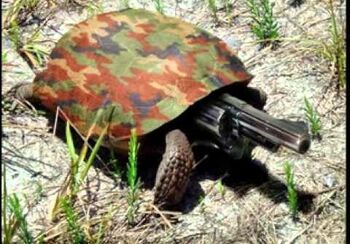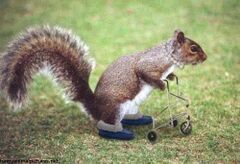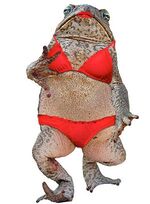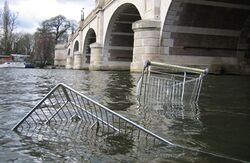Invasive species
An invasive species is an organism that enters your country, plants a flag in it and start to tax the indigenous species. Ecologists are almost universally hostile to invasive species as the arrival of a new organism inevitably disrupts existing ecosystems and because watching Asian rodents eat Mrs Tiggywinkle from in the inside out wasn't in the Beatrix Potter books Mummy used to read them. The general public are often considerably less hostile to newly arrived species providing that they are tastier than existing species and do not jump the queue for Social Housing.
There have been only rare examples of the establishment of an invasive species being universally thought to be a good thing. Most recent of these was 2003's appearance of American and British Army Ants which arrived in Iraq from both land and sea. These ants swiftly caused the existing Army Ants to flee, allowing the previously threatened Jihadi Ant species to proliferate and peacefully detonate themselves the way nature had always intended.
Eradication[edit]
In 1985 the United Nations International Conservation And Nature Trust (ICANT) turned their minds to the problems caused by invasive species. After many months of discussion they concluded that every member nation should seek to exterminate those species most easily dealt with first and slowly expand the net to deal with ever smaller problematic critters. Large mammals, being particularly easy to track down and easier to process into burgers, were given first priority. The discussion then turned to the correct method of eradication. Fire-arms were unanimously adopted, following which the committee eradicated each other in a hail of automatic gunfire, it having chosen to meet in New York whereas Homo Sapiens is only truly native to Africa.

Since then the world has been largely without guidance and eradication programs have been adopted piecemeal, seemingly at random. But success is possible. History shows that in 1588 Spanish Moss had taken grip on the Iberian Peninsula and was beginning to take over the rest of continental Europe. A particularly nasty infestation at La Coruna took over the Spanish fleet, forcing it to sail North to invade Great Britain. This might have been disastrous for the much cherished native mosses had the indigenous Oak population not chopped itself down and had itself hewn into warships to sink the Armada before it could land. But relying on nature to deal with the issue has rarely been a successful strategy.
An ingenious plan to protect your country from invasion is to make it completely uninhabitable. A combination of some simple but effective methods was shown to be at least partly effective thousands of years ago when King 'Ell of Atlantis burned all existing vegetation so that no invasive animals would be able to establish themselves. The subsequent extinction of all existing Atlantean fauna was considered a price worth paying until the lack of herbivores threatened to allow invasive plant species to overrun the continent even as the native flora re-established itself. Ell is said to have then ordered every square metre of soil to be ploughed with salt so that nothing would be able to grow in the future. Fearing that rainfall might eventually wash out the salt and restore fertility Plato tells us that Ell called upon Poseidon to bring forth lava floes and earthquakes such that all Atlantis was soon subsumed below the waves where no Cane Toad or Sparrow could despoil it. Sadly, the area was immediately inhabited by several species of Cod which had hitherto been unknown on its lush-grasslands.
Between 1914 and 1918 repeated application of high explosives and Mustard gas by British and German armies rendered large parts of Belgium completely uninhabitable, a condition successfully maintained to this day. Consequently no migrants have established themselves in the area and there are no reported cases of any attempts being made. Most famously if all, the introduction of the Dodo-farming to Mauritius in the 1620's had resulted in human depopulation as farmers had not thought to warn inhabitants that the Dodo's only prey was children. Fortunately, the Dodo's voracious appetite drew the birds to the ships of French explorers who stored them in vast vats, treading them into passable Chablis for the long voltage home. Thanks to this successful repulsion of a dangerous invasive species within twenty years the human population was once again thriving and soon exterminating the Mauritian Blue Pigeon, the Mauritian Polar Bear and the Mauritian Ox-eating Daffodil.
Successful invasions[edit]
Islands are particularly susceptible to invasion by foreign organisms as their beaches provide ample points of entry for landing-craft and because their native inhabitants generally neglect to lay even the most perfunctory minefields in the surrounding dunes. To repel an invasive species requires a concerted effort to fight them not just on the beaches but also in the fields and in the air. It is particularly important to never surrender.
Great Britain[edit]
Gray Squirrel - in the late Nineteenth century British naturalists became concerned the the indigenous Red Squirrel with its brightly coloured fur, handsome features and large bushy tail was simply not cute enough. After a Parliamentary Select Committee inquiry it was decided that a drab, frequently rabid tree-rat prepared to predate the nestlings of endangered bird species would make the reds seem cuter by comparison. The North American Gray Squirrel was a perfect fit and, as a bonus, it was discovered that the Gray also stripped bark from rare Elm trees when hungry. Or bored.
A few pairs were released in Hyde Park and had soon established themselves, begun to breed and learned to spell in correct British English. Soon they had changed their name by Deed Poll to Grey Squirrels and spread across the nation. As virulently anti-communist as any other Americans the Grey Squirrels began to exterminate Reds wherever they found them and to imprison any Grey thought have perhaps once known a Red who were unable to confirm that they were not now nor ever had been a member of the Communist Party. There have been reports of Grey's abducting humans and carrying out medical experimentation in them. These remain unconfirmed, however. Descriptions of Greys as being around five feet tall, bipedal, hairless with large heads and eyes suggest an unusual rate of recent evolution, as does the ability to engineer interstellar spacecraft.
Less than one hundred years later many British children are unaware that a native squirrel still exists in the remoter parts of the country (Wales, Northern Scotland, Hampshire). The majority believe that it is normal for their environment to be trashed by thuggish rodent skinheads intent on catching and devouring weaker members of the ecosystem.
A spokesman for Environment Minister, David Twatt, said: "Of course, most of these children live on Council Estates where similar conditions prevail."
Australia[edit]
In 1845, having introduced beagles, horses, effeminate riding gear and the concept of drunkenly trespassing on neighbouring farms to Australia British settlers felt that something was missing from their culture. Soon they had successfully introduced the European Red fox and equally successfully wiped out fifteen species of potoroos, bilbys, and bandicoots. With fox numbers swiftly declining again they further introduced rabbits to provide the fixes with food and to destroy what little grass had survived the previously introduced sheep. Within twenty years they had successfully turned the centre of the southern continent into the vast red sand-pit we know today, rendering it so unfit for human habitation that they retired to the coastal strip to poison native aquatic species with sunblock and board-wax.
Queensland is not just the epicentre of Australian cross-dressing but also the home to Australian cocaine production. Sadly cocaine production was declining due to repeated infestations of Beatles, themselves an introduced species of noisy pests known for their impressive drug-tolerance and predilection for unsuitable mating. What could be done to stop the slump in cocaine production and Australians sobering up long enough to realise where they were and ask to be allowed to come home? In this case the answer was the Cane Toad.
Thousands of cane toads were released and soon spread around the coastal fringe as far as Western Australia. Sadly, as Cane Beatles as are small lighted insects that feed on the tips of plants and cane toads are the size of obese American third graders there seems to have been only a small effect on Beatle numbers, with only two recorded deaths since 1981. Currently cocaine production in Queensland is thought to have ceased altogether, forcing farmers to plant sugar crops. Inadvertently then, the introduction of a species to allow the continued production if narcotics has led to an explosion in type II diabetes and numerous explosions of domestic dogs as it seems the toxins in toad skin react violently with canine stomach acid.
North America[edit]
Florida's Everglades are a sub-tropical wetland paradise known for its vast flocks of migrating Penguin and resident population of six foot tall Disney characters. In the 1980s there was an influx of Burmese Python, possibility as a result of a security crackdown by Myanmar's ruling military Junta. Snake species are thought to have been particularly hard hit by a Burmese Supreme Court ruling that limblessness was no excuse for not being able to show a valid identity card to wildlife officers.
The bleeding hearts and liberals rescued several thousand Burmese boat- pythons from rickety fishing vessels in the Indian Ocean and rehoused them in Florida in the hope that they might deal with a recent infestation of Cubans. Previously home to peaceable populations of Crocodiles, Alligators and Diamondback Rattlesnakes the Everglades was ill-prepared to respond to the new influx. Numbers of Eastern Rednecks are in decline and the population of Giant Mute Mice is now restricted to one tiny reserve heavily patrolled by armed ticket inspectors.
Becoming an invasive species[edit]
The British became arguably the most successful invasive species by building up its Naval forces and introducing the persuasive force of the Maxim heavy-machine gun to native populations armed with twigs. But this clearly was not a tactic available to Felis Catus, the domestic cat, which is notoriously averse to both water and the smell of gun-powder. So how else can a species spread itself globally?
- Reproduction - the ability to be able to reproduce in large clutches several times a year allows an organism to swiftly establish itself in a new territory. The ability to interbreed with existing populations is an almost sure-fire guarantee of success. In 1988 there were no Wal-Mart stores in the UK. By 1992 there were four but cross breeding with the existing population of Asda stores has resulted in numbers now estimated at over three hundred million.
- Adaptability - shopping trolleys (now considered a separate sub-species of the American Shopping cart) established themselves in Europe in the 1950s. Although a land-based creature the shopping trolley, like most amphibians, must return to the water to breed. Every Autumn finds the rivers of Europe full of breeding-swarms of trolleys which sadly die after spawning, returning their nutrients to the river in the form if rust to nourish the young. Although the early life-cycle of the species is not yet fully understood it us thought that the young then spread across country in rivers and streams as cans before adopting their second body form as shopping baskets and taking their place in convenience stores too small to support a fully grown adult. In one of life's most celebrated examples of symbiosis the baskets allow themselves to be taken by humans and used to transport goods to large to comfortably shop lift. Some of these humans then take the basket home with them from where the young baskets make their way to supermarket forecourts where they huddle together for warmth while awaiting the chance to moult a second time and become a fully fledged trolley.
- Hardiness - chewing gum first migrated from Mexico to the United States in the 1860s. Since then it has become a mainstay of sidewalks, the undersides of tables and the hair if toddlers across every continent. One of the keys to chewing gum's success is its toxicity which causes those who attempt to eat it to dispose of it quickly without swallowing, thereby avoiding digestion. But it is gum's sheer hardiness that allows it to survive long after it's human attempted predator has been put in a horizontal phone booth. There being no known solvent that can dislodge gum allows it to cling to life on a paving slab with a tenacity lichen could only dream if had it the balls to evolve cognitive functions. Equally immune to both freezing temperatures and fire nothing can dislodge gum from its chosen home except the sole of a shoe, which it will allow itself to adhere to only in part - the better to spread itself to new locations where it can begin to breed again.




